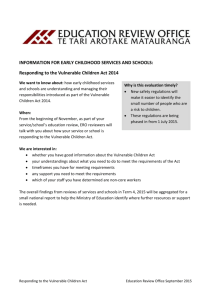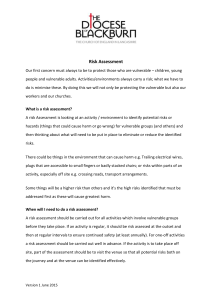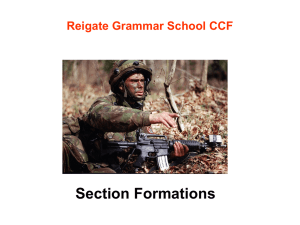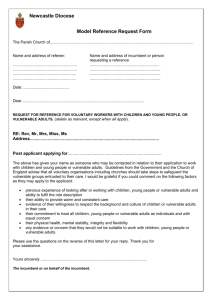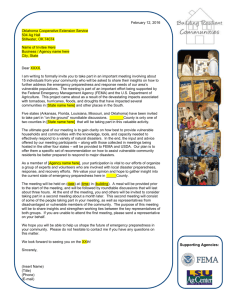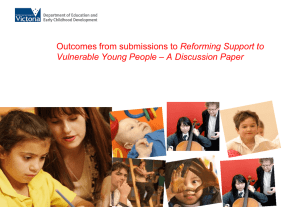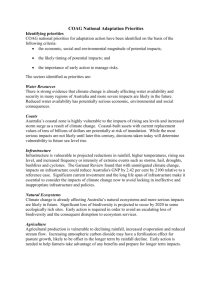(HHSRS) - A short guide (Word, 623Kb)
advertisement
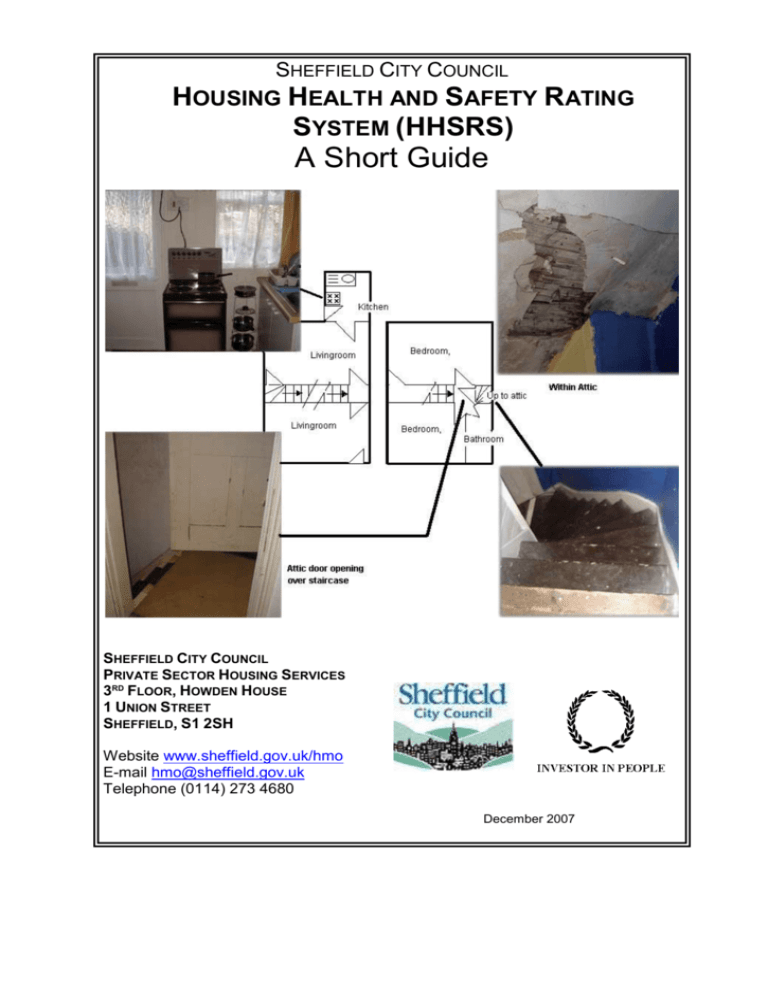
SHEFFIELD CITY COUNCIL HOUSING HEALTH AND SAFETY RATING SYSTEM (HHSRS) A Short Guide SHEFFIELD CITY COUNCIL PRIVATE SECTOR HOUSING SERVICES 3RD FLOOR, HOWDEN HOUSE 1 UNION STREET SHEFFIELD, S1 2SH Website www.sheffield.gov.uk/hmo E-mail hmo@sheffield.gov.uk Telephone (0114) 273 4680 December 2007 What is the Housing Health and Safety Rating System (HHSRS)? This is a new approach to the way in which Councils assess housing conditions. It uses a risk assessment approach. It provides a system to enable risks to be assessed and has been introduced by the Housing Act 2004, coming into force on 6 April 2006, replacing the “Fitness Standard”. Why the new system? The fitness standard did not deal with many of the hazards that affected health and safety; Assessments made under the fitness standard were ‘property based’ and did not directly consider the effect of the particular defect or omission, on the occupant or visitor. The HHSRS on the other hand addresses all the key issues that affect health and safety, it provides an analysis of just how hazardous a property is and includes evidence and statistical information to assist inspectors in making their judgements. Each year on average, housing conditions are implicated in up to 50,000 deaths and around 0.5 million illnesses requiring medical attention. These statistics and many others form part of the evidence base of the system and are drawn from extensive research in the UK (in this case the Home Accident Surveillance System). The fitness standard did not address many of the conditions that caused these deaths and injuries. How is the system applied? Councils have a duty keep the housing conditions in their area under review. Either as a result of that review, or for some other reason such as a complaint from a tenant or a neighbour, they can inspect a property if they have reason to think that a health or safety hazard exists there. The scoring of hazards found during an inspection must be carried out in accordance with the method set out in the HHSRS Regulations. As well as providing the legal basis for HHSRS, the 2004 Act contains a package of enforcement measures for Councils to use. These powers can be used to deal with poor housing in the private sector, or any housing owned by a public sector landlord such as the Ministry of Defence, the NHS, a Fire and Rescue Authority or the Police, unless it has Crown exemption. Councils have a duty to deal with serious ‘Category 1’ hazards under HHSRS, and discretionary powers to deal with less serious ‘Category 2’ hazards. How are assessments made? The assessment process is not just a question of identifying defects, but is all about risk assessment, outcomes and effects. When an inspector finds a hazard, two key tests are applied – what is the likelihood of a dangerous occurrence as a result of this hazard and if there is such an occurrence, what would be the likely outcome? For example a staircase that had a broken stair would represent a serious hazard in that an occupant could trip or fall down the stairs. However a broken stair at the top of the staircase would obviously be more dangerous than one at the bottom. If, for example, a glass door was situated near the bottom of the staircase, that would increase the potential severity of the outcome even more. Dwellings are assessed against the average for the type and age of building. The inspector also judges whether the condition increases or lowers the likelihood of an occurrence that would give an harm outcome. Hazards are assessed according to their likely impact on people in a vulnerable group, such as the elderly or the young. The resultant enforcement in relation to the hazards may be influenced by the presence in the property of the vulnerable group. Examples of the 29 hazards. These follow overleaf. Each hazard is identified with a brief description of the hazard and the vulnerable group is identified in italics. 1. Damp & Mould Growth. Caused by dust mites, mould or fungal growths caused by dampness and/or high humidity. It includes threats to mental healthy and social well being caused by living with damp, damp staining and/or mould growth. Most vulnerable: 14 years or less 2. Excess cold. From sub-optimal indoor temperatures. Most vulnerable: 65 years plus 3. Excess Heat. Caused by excessively high indoor air temperatures. Most vulnerable: 65 years plus 4. Asbestos (& MMF). Caused by exposure to asbestos fibres & manufactured mineral fibres (MMF) 7. Lead. Threats to health from the ingestion of lead. Most vulnerable: Under 3 years Most vulnerable: No specific group 5. Biocides. Threats to health from those chemicals used to treat timber and mould growth in dwellings. Insecticides and rodenticides to control pest infestations (e.g. cockroaches or rats and mice), these are not considered for the purpose of the HHSRS. Most vulnerable: No specific group 6. Carbon monoxide and fuel combustion products. Hazards due to excess levels of carbon monoxide, nitrogen dioxide, sulphur dioxide and smoke in the dwellings atmosphere. Most vulnerable: CO2 65 years plus, NO2, SO2 and smoke, Most vulnerable No specific group. 10. Volatile organic compounds. VOCs are a diverse group pf organic chemicals, which include 8. Radiation. formaldehyde, that This category covers are gaseous at room the threats to health temperature, and from radon gas and its are found in a wide daughters, primarily variety of materials airborne, but also in the home. radon dissolved in Most vulnerable: water. While rare, No specific group leakage from microwave ovens might also be 11. Crowding and considered. Evidence space. of health risks from Health hazards low-level exposure to linked to a lack of electro-magnetic fields living space for from phone masts sleeping and normal have not, to date, been family/household proven. life. Most vulnerable: Most vulnerable: All persons aged No specific group. between 60 and 64 years who have had lifetime exposure to 12. Entry by radon. intruders. Problems keeping a dwelling secure 9. Uncombusted fuel against unauthorised gas. entry and the The threat of maintenance of asphyxiation due to defensible space. fuel gas escaping into the atmosphere within a dwelling. Most vulnerable: No specific group psychological effect associated with the view from the dwelling through glazing. Most vulnerable: No specific group. 14. Noise. Threats to physical and mental health caused by noise exposure inside the dwelling or within its curtilage. Most vulnerable: No specific group. Most vulnerable: No specific group. 15. Domestic hygiene, pests and refuse. Health hazards due to poor design, layout and construction to the point where the dwelling cannot be readily kept clean and hygienic; access into, and harbourage within, the dwelling for pests; and inadequate and unhygienic provision for storing and disposal of household waste. 13. Lighting. Threats to physical and mental health linked to inadequate natural and/or artificial light. It includes the Most vulnerable: No specific group 16. Food safety. Threats of infection due to inadequate facilities for the storage, preparation and cooking of food. Most vulnerable: No specific group. 17. Personal hygiene, sanitation and drainage. Threats of infection and threats to mental health associated with personal hygiene, including personal washing and clothes washing facilities, sanitation and drainage. Most vulnerable: Children under 5 18. Water supply. The quality and adequacy of the water supply for drinking and for domestic purposes such as cooking, washing, cleaning and sanitation. Also threats to health from contamination by bacteria, protozoa, parasites, viruses and chemical pollutants. Most vulnerable: No specific group. 19. Falls associated with baths etc. Falls associated with a bath, shower or similar facility. Most vulnerable: 60 years plus 20. Falling on level surfaces etc. Falls on any level surface such as floors, yards and paths. It also includes falls associated with trip steps, thresholds, or ramps, where the change in level is less than 300mm. Most vulnerable: 60 years plus. 21. Falling on stairs etc. Fall associated with stairs, steps and ramps where the change in level is greater than 300mm. It includes falls on internal stairs or ramps within the dwelling, internal common stairs or ramps within the building, access to the dwelling, and to shared facilities or means of escape in case of fire. It also includes falls over guarding (balustrading). Most vulnerable: 60 years plus. 22. Falling between 25. Flames, hot levels. surfaces etc. Falls from one level to Burns or injuries another inside or caused by contact outside a dwelling, with a hot flame or where the diffetrence in fire, and contact with levels is more than hot objects or hot 300mm. For example, non-water based falls out of windows, liquids, and scalds falls from balconies or injuries caused by landings, falls from contact with hot accessible roofs, into liquids and vapours. basemen wells, and It includes burns over garden retaining caused by clothing walls. catching alight from Most vulnerable: a controlled fire or Under 5 years. flame. Most vulnerable: Under 5 years. 23. Electrical hazards. Hazards from electrical 26. Collision and shock and electricity entrapment. burns, including from This category lightning strikes. includes risks of physical injury from: Most vulnerable: Under 5 years. A) trapping body parts in architectural features, such as trapping limbs or fingers in doors or windows. Most vulnerable under 5 years. 24. Fire. B) Striking (colliding Threats from uncontrolled fire and with) objects such associated smoke. It as architectural includes injuries from glazing, windows, clothing catching alight, doors, low ceilings and walls. which appears to be common when people attempt to put out a fire. It does not include clothing catching alight from a controlled fire by reaching across a gas flame or an open Most vulnerable: fire used for space 16 years over. heating. Most vulnerable: 60 years plus. 27. Explosions. Threat from the blast of an explosion, from debris generated by the blast, and from the partial or total collapse of a building as the result of an explosion. Most vulnerable: No specific group. 28. Position and operability of amenities etc. Threats of physical strain associated with the functional space and other features at dwellings. Most vulnerable: 60 years plus. 29. Structural collapse and falling elements. The threat of the dwelling collapsing, or of an element or a part of the fabric being displaced or falling because of inadequate fixing or disrepair, or as a result of adverse weather conditions. Structural failure may occur internally or externally. Most vulnerable: No specific group.
